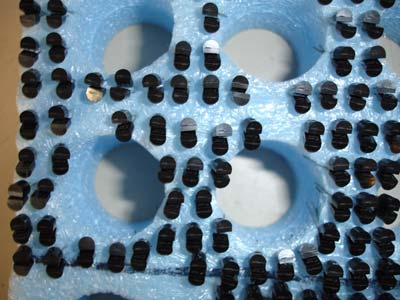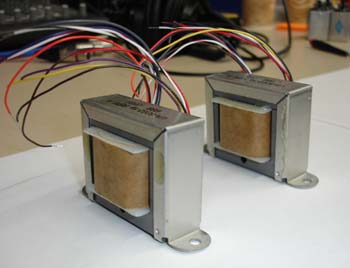Volume 4, Number 1, January 2006
[UA Universe] [Ask the Doctors] [Artist Interview] [Analog Obsession]
[Support Report] [The Channel] [Plug-In Power] [Playback] [Featured Promotion]
[Graphic-Rich WebZine]
[Back Issues] [UA Home]
Analog Obsession: An Interview with UA's Senior Analog Obsessor
This month's Analog Obsession is an interview with UA's Senior Analog Obsessor-our Quality Control Manager-known around headquarters simply as "Q." It's Q's job to make sure every unit that leaves UA is a masterpiece, built to last a lifetime.
 |
|
Matched pairs of 2-1176 FETs
|
We have a very thorough test department here for all the equipment that we build. We use a set of computerized testers that are built by a company called Audio Precision. We write custom software for the testers that allow us to check what we consider to be the most important parameters. There are a handful which are common to pretty much everything: frequency response, distortion and noise floor. And then, depending on the product, if it is a compressor, we always want to look at the compressor curves, how those work. If it has an equalizer, we want to look at that and make sure it meets its response specs; so, we tailor a set of custom-designed software products for each one of the products that we manufacture. When the software is finished, written and put on the machines, it leads the tester step by step. It tells what to hook up to the machine and how to set the knobs. It automatically brings up the proper tests and performs them to a very high standard of accuracy. That is one way that we can ensure that every unit that goes through here gets what we consider to be the best in the way of care.
What is your quality control process?
There are a number of people involved in the quality control. We do almost everything here; boards are made locally, we do a lot of the wiring harnesses, and a lot of the subassemblies are all created here. So it is not like the units are outsourced anywhere. We have a lot of quality control that goes on right here in the factory. Because it moves around inside our factory a lot, things get double- and triple-checked by various people. I feel that is one of the things that help us keep our quality control up. Each person is not only responsible for his or her own job, they also look out and make sure things done upstream from them are done correctly.
How do I know the units were assembled correctly?
We take a lot of time when we bring new people into the company; we have experienced assemblers train them. Also, we keep logs for each product that show the process of putting them together: where all the nuts and bolts go, where the wiring is done and how it is done. It is documented with pictures and drawings. A person who comes to work on our assembly line has to familiarize themselves with those pictures and drawings. They also undergo an apprentice program with people who are experienced on the production line. And of course, like I say, we all check each other's work so everything gets looked at a lot before it gets the final stamp of approval to go out of here.
How do I know the channels in my multi-channel units are matched?
The computer testers that we use, the Audio Precision, have a template that we look at each product against. In a multi-channel unit, we look at each channel that way too. For instance, the 2-1176 stereo compressor-one of the checks that we do to make sure it is in good shape for stereo operation is that the two channels are overlaid on top of each other so we can look at any anomalies in frequency response or noise performance. That allows us to, if necessary, select components to make sure that the two channels mirror each other as closely as possible. For instance, the input or the output transformers vary a little bit. If they fall outside the parameters that we've specified, we will see that on the computer screen immediately after the unit has been tested. We can look at which one seems to be the offending channel and swap parts out until we have what we consider to be the best possible match.
How do you match tubes and transistors?
We don't match tubes, we do match a couple of different components that we use. We match Field Effect transistors (FETs). We use a lot of FETs, which are the heart of our 1176 style compressor. We use a specific part from a specific manufacturer. We have built customized test equipment that allows us to go through the components that we receive from the manufacturer and test them to a very specific level and grade. We reject about 40 percent of the parts that we get. It's not that they are bad parts; they fall within the manufacturer's specifications, but they don't meet our specifications for this particular part. The test equipment that we've designed and built here lets us go through and collect a lot of very accurate data about each one of those components. We have a process to bin and select those. We use those in the 2-1176. Since it is matched as a stereo compressor, it is important that each one of those components act together so you get an accurate stereo image and that is part of what we do in this process.
Do you "burn in" the units? Why?
 |
|
Matched 2-1176 transformers await assembly
|
Is there anything more I need to know to be sure that UA stuff is the best quality possible in audio gear?
I think part of what makes it the best is that most of the people here have been in the music industry for a long time. A lot of us are very technically minded and we've seen what goes on out on the road and in the studio. So we are very familiar with the expectations our customers have for our products. We don't build just average gear we build very high-quality, boutique-style gear. That has been one of the hallmarks of our quality.
A good thing to add about our testing process is that although we use the AP technology to assure us that each product is performing to spec, the final test is a listening test by a trained technician, to be sure that there's nothing weird that might fly "under the radar" of our machines!
Questions or comments on this article?